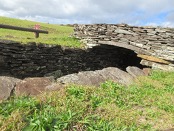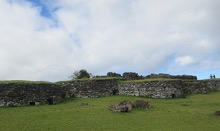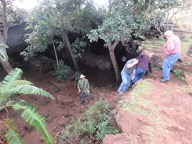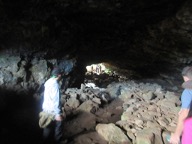- About MAA
- Membership
- MAA Publications
- Periodicals
- Blogs
- MAA Book Series
- MAA Press (an imprint of the AMS)
- MAA Notes
- MAA Reviews
- Mathematical Communication
- Information for Libraries
- Author Resources
- Advertise with MAA
- Meetings
- Competitions
- Programs
- Communities
- MAA Sections
- SIGMAA
- MAA Connect
- Students
- MAA Awards
- Awards Booklets
- Writing Awards
- Teaching Awards
- Service Awards
- Research Awards
- Lecture Awards
- Putnam Competition Individual and Team Winners
- D. E. Shaw Group AMC 8 Awards & Certificates
- Maryam Mirzakhani AMC 10 A Awards & Certificates
- Two Sigma AMC 10 B Awards & Certificates
- Jane Street AMC 12 A Awards & Certificates
- Akamai AMC 12 B Awards & Certificates
- High School Teachers
- News
You are here
Mathematical Mysteries of Rapa Nui with Classroom Activities: Mathematical Mystery 3 – How Were the Hare Paenga Foundations Laid Out?
In addition to fitting ellipses over the hare paenga images with Desmos and GeoGebra, we analyzed twelve of the Tukuh Technologies drone images using rough measurements of the major and minor axes of these hare paenga remains.
| \(2a\) in feet | \(a\) in feet | \(b\) in feet | \(c\) in feet | \(a-c\) in feet | \(a-c\) in inches |
| 37.50 | 18.75 | 3.125 | 18.48775 | 0.262251 | 3.147008 |
| 37.50 | 18.75 | 3.125 | 18.48775 | 0.262251 | 3.147008 |
| 37.50 | 18.75 | 2.604167 | 18.56827 | 0.181726 | 2.180707 |
| 45.83 | 22.91667 | 3.125 | 22.7026 | 0.214068 | 2.568816 |
| 37.50 | 18.75 | 3.645833 | 18.39213 | 0.357871 | 4.294455 |
| 40.54 | 20.27027 | 3.716216 | 19.92671 | 0.343565 | 4.122777 |
| 33.33 | 16.66667 | 2.864583 | 16.41865 | 0.248021 | 2.976247 |
| 32.29 | 16.14583 | 2.864583 | 15.88969 | 0.256148 | 3.073777 |
| 30.21 | 15.10417 | 2.604167 | 14.87798 | 0.226191 | 2.714289 |
| 33.33 | 16.66667 | 2.604167 | 16.46196 | 0.204708 | 2.456492 |
| 35.94 | 17.96875 | 2.864583 | 17.73894 | 0.229806 | 2.75767 |
| 40.63 | 20.3125 | 3.645833 | 19.98263 | 0.329869 | 3.958424 |
Averages
| \(2a\) in feet | \(a\) in feet | \(b\) in feet | \(c\) in feet | \(a-c\) in feet | \(a-c\) in inches |
| 36.84 | 18.42 | 3.07 | 18.16 | 0.26 | 3.12 |
These measurements were similar to ones found from fieldwork on Rapa Nui in 1968–1969: “hare paenga in the survey area were of average size, corresponding to Métraux’s [1971, 200] observations of general house dimensions—10 to 15 meters long and 1.5 to 2 meters broad. The smallest was 4.8 x 1.3 meters and the largest more than 40 meters long as calculated from the length of the house pavement” [McCoy 1976, 50].
Notice the last column of the table above. The value \(a-c\) is the distance between a focus and the nearest end of the major axis. For the examples in the table, this value is roughly 3 to 4 inches, which could correspond to the width of a hand or 3–4 fingers. Although there is no known surviving evidence of how the hare paenga foundations were laid out, one method that would work would be based on the definition of an ellipse using rope (with length equal to the desired length of the boat house), 2 stakes or poles (set at the foci about a hands-width in from the ends of the major axes), and a stick for marking the ellipse in the dirt. (See the corresponding class activities.) The video below demonstrates how the foundations could have been laid out using the definition of an ellipse.
Even though we don’t know exactly how the Rapanui laid out the foundations, there is evidence that they used rope or string for measurements. The following quote is from an expedition to Easter Island in 1786: “The care they took to measure our vessel convinced me, that they had not contemplated on arts with stupidity. They examined our cables, our anchors, our compass, and our steering wheel; and in the evening they returned with a string to take their measure over again” [La Pérouse 1798, 328, emphasis added].
It is not known how soon after Rapa Nui was inhabited that the people started building hare paenga, but the use appears to have been discontinued by the mid-19th century [Métraux 1971, 196, 200]. In her expedition of 1910, Katherine Routledge met older people, many of whom “were born and brought up in these houses, which are known as ‘hare paenga’” [Routledge 1920, 200]. It should be mentioned that the hare paenga were not the only type of houses used in the past on Rapa Nui. In fact, it is thought that only a select few had a hare paenga in which to sleep or to get out of the rain. Others may have lived in thatched huts without foundations. Caves and rock shelters of various sizes were also used.


Figure 15. Subterranean dwelling and stone houses at Orongo, a ceremonial village at the southwestern tip of Rapa Nui.


Figure 16. Ana Te Pahu—once inhabited and the largest cavern complex on the island.
In some locations the wind is too strong to make a thatched dwelling practical. Stone elliptical houses were constructed, which Métraux [1971, 204] suggests were modeled after the hare paenga. The measurements of one such house [La Perouse 1798, 192] were 26 feet for the major axis and 6 feet for the minor axis, giving a distance of a little over 4 inches between an end of the major axis and a focus, similar to the hare paenga discussed above.
Ximena Catepillán (Millersville University), Cynthia Huffman (Pittsburg State University) and Scott Thuong (Pittsburg State University), "Mathematical Mysteries of Rapa Nui with Classroom Activities: Mathematical Mystery 3 – How Were the Hare Paenga Foundations Laid Out?," Convergence (March 2021)




